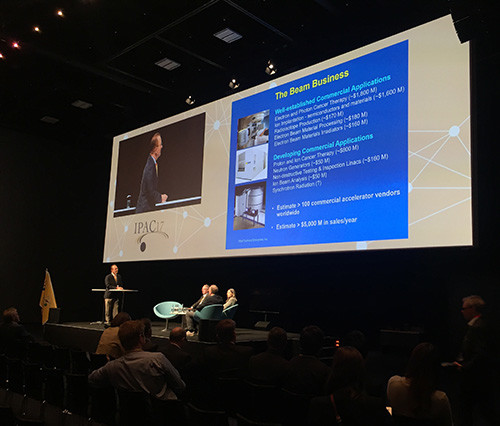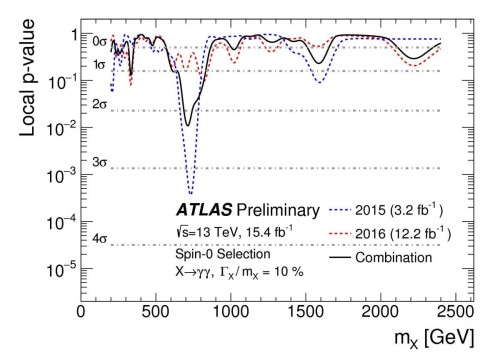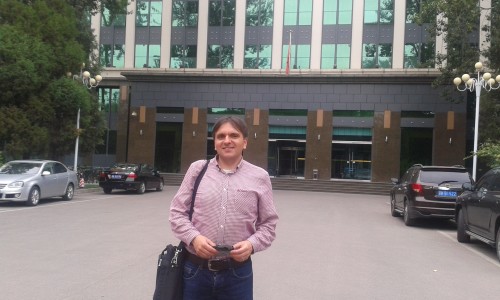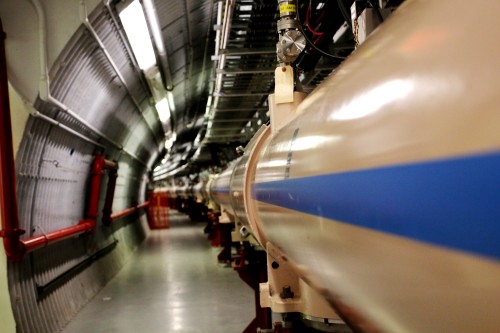Tag archives: particle accelerator
Science, scepticism and fear at the theatre

Sceptical siblings: Olivia Williams (left) and Olivia Colman in Mosquitoes by Lucy Kirkwood. (Courtesy: National Theatre/Brinkhoff & Mogenburg)
By Tushna Commissariat
Working at Physics World for the last six years has taken me to some pretty cool labs – everywhere from CERN to the Laser Interferometer Gravitational-wave Observatory (LIGO). My job has allowed me to meet some quite famous people too…at least in the world of physics, that is. But getting to spend a morning at the National Theatre in London watching Olivia Colman and Olivia Williams rehearse for a play is not usual even for me. That is precisely why I jumped at the chance, when I found out that the pair star as sisters in the recently opened play Mosquitoes.
You may be wondering what a play with that moniker has to do with physics. Mosquitoes tells the story of rational and lucid Alice (played by Williams), a particle physicist at the Large Hadron Collider (LHC), and her often-illogical sister Jenny (played by Colman) “who spends a lot of time Googling” and is easily swayed by the bad science she chances upon. Written by Lucy Kirkwood and directed by Rufus Norris – the National Theatre’s current artistic director, the play follows the siblings through a family tragedy, as well as the fairly disastrous switching on of the LHC in 2008, and takes a hard look at our relationships with science, facts, belief and so much more. Kirkwood, whose previous successes include Chimerica and The Children, was commissioned to write the play by the Manhattan Theatre Club as part of its Alfred P Sloan Foundation initiative, which aims to “stimulate artists to create credible and compelling work exploring the worlds of science and technology and to challenge the existing stereotypes of scientists and engineers in the popular imagination”.
View all posts by this author | View this author's profile
Snapping the Milky Way, art inspired by SLAC blueprints, doppelganger magazine covers

Top tip: use a remote shutter control. (Courtesy: Clifton Cameras)
By Hamish Johnston
If you are lucky enough to live somewhere with dark skies, you know that the Milky Way is a truly majestic sight. But how exactly would you go about capturing its magnificence with a camera? UK-based Clifton Cameras has put together an infographic with a few helpful hints. The image above is an excerpt and you can view the entire infographic here.
View all posts by this author | View this author's profile
Happy birthday Fermilab

Little house on the prairie: the first director’s office on the National Accelerator Laboratory site. (Courtesy: Fermilab)
By Matin Durrani
Music lovers will remember 1967 as the year the Beatles released Sgt. Pepper’s Lonely Hearts Club Band. For sports fans it was the year when Celtic became the first British team to win football’s European Cup. As for scientists, 1967 will go down in history as the year in which the first human heart transplant took place and the first radio pulsars were detected by Jocelyn Bell Burnell, Antony Hewish and others at the University of Cambridge, UK.
View all posts by this author | View this author's profile
A spotlight on accelerators in industry – sort of

Robert Kephart of Fermilab speaking about the “beam business” at IPAC17.
By Margaret Harris at the International Particle Accelerator Conference in Copenhagen
Normally, you’d expect a particle-accelerator conference to focus on research – either the fundamental research done at accelerator facilities around the world, or the applied research required to get such facilities up and running in the first place. And for the most part, that has been absolutely true of the 8th International Particle Accelerator Conference (IPAC), which is taking place this week on the outskirts of Copenhagen, Denmark.
On Tuesday, however, the conference organizers dedicated a session to the ways that accelerator science engages with industry. In a two-hour series of talks, audience members heard from speakers as varied as Bjerne Clausen, CEO of the Danish chemical technologies firm Haldor Topsoe; Bob Kephart, director of the Fermilab-affiliated Illinois Accelerator Research Center (IARC); and Giovanni Anelli, who leads the Knowledge Transfer group at CERN.
View all posts by this author | View this author's profile
Award-winning ‘Bailys Beads’, schoolyard accelerators , pulsar poems and more
By Tushna Commissariat
Its officially that time of the year again when we can marvel at this year’s winners of the Insight Astronomy Photographer of the Year 2016. The awards ceremony, held at the Royal Greenwich Observatory, has unveiled some truly spectacular and ethereal shots of our universe. The overall winner this year is a truly amazing composite image of the 2016 total solar eclipse that shows the ‘Baily’s Beads’ phenomenon and was taken by photographer Yu Jun in Luwuk, Indonesia. In the video above, the judges explain why this particular image was the main winner for the year.
View all posts by this author | View this author's profile
And so to bed for the 750 GeV bump

No bumps: ATLAS diphoton data – the solid black line shows the 2015 and 2016 data combined. (Courtesy: ATLAS Experiment/CERN)
By Tushna Commissariat
After months of rumours, speculation and some 500 papers posted to the arXiv in an attempt to explain it, the ATLAS and CMS collaborations have confirmed that the small excess of diphoton events, or “bump”, at 750 GeV detected in their preliminary data is a mere statistical fluctuation that has disappeared in the light of more data. Most folks in the particle-physics community will have been unsurprised if a bit disappointed by today’s announcement at the International Conference on High Energy Physics (ICHEP) 2016, currently taking place in Chicago.
The story began around this time last year, soon after the LHC was rebooted and began its impressive 13 TeV run, when the ATLAS collaboration saw more events than expected around the 750 GeV mass window. This bump immediately caught the interest of physicists the world over, simply because there was a sniff of “new physics” around it, meaning that the Standard Model of particle physics did not predict the existence of a particle at that energy. But also, it was the first interesting data to emerge from the LHC after its momentous discovery of the Higgs boson in 2012 and if it had held, would have been one of the most exciting discoveries in modern particle physics.
In flight around the world’s brightest laser and the inverse Cheerio effect
By Tushna Commissariat
If you have never been one of the lucky few to have wandered the tunnels of a particle accelerator, but have always wondered what lies within, take a look at the video above. The European X-ray Free Electron Laser (European XFEL) – which is currently under construction in Germany and will come online next year – will provide ultrashort (27,000 X-ray flashes per second) and ultrabright X-ray laser flashes that are needed to study chemical reactions in situ or to study extreme states of matter (you can read more about the kind of research that will be done there in the September issue of Physics World magazine). The XFEL tunnel is 3.4 km long and you can zoom across all of it in the 5 minute long video. I particularly enjoyed watching particular locations where engineers could be seen carrying out tests, as well as watching folks on bicycles wobble out of the camera’s way.
On a slightly related note, if, like me, you occasionally get a bit muddled when it comes to certain details of different particle accelerators – for example which came first, the synchrotron or the cyclotron – take a look at this excellent “primer” over at Symmetry magazine.
View all posts by this author | View this author's profile
China eyes new high-energy collider

Matin Durrani outside the Institute of High Energy Physics in Beijing before interviewing Xinchou Lou.
By Matin Durrani in Beijing, China
I had just landed in Beijing this morning when I saw an e-mail from my colleague Mingfang Lu waiting for me on my phone. Mingfang, who’s editor-in-chief at the Beijing office of the Institute of Physics, which publishes Physics World, has been helping me to organize my itinerary for the next week as I gather material for our upcoming special report on physics in China. You may remember we published a Physics World special report on China in 2011 but so much has happened since then that we felt it’s easily time for another.
Mingfang’s e-mail was to say we would be off at 2.30 p.m. to interview Xinchou Lou, a particle physicist at the Institute of High Energy Physics, about the country’s ambitious plans for a “Higgs factory”. If built, this 240 GeV Circular Electron–Positron Collider (CEPC) would be a huge facility (50 km or possibly even 100 km in circumference) that will let physicists study the properties of the Higgs boson in detail. I say “if”, but knowing China’s frenetic progress in physics, it will almost certainly be a case of “when”.
View all posts by this author | View this author's profile
The accelerator tree bears fruit

Accelerator science is blossoming in Salt Lake City.
By Hamish Johnston at the APS April Meeting in Salt Lake City
This morning Mei Bai of the Jülich Institute for Nuclear Physics in Germany used a lovely phrase during her talk at the APS April Meeting. She showed a slide called the “accelerator tree”‘, which refers to a paper by Ugo Amaldi called “The importance of particle accelerators“.
View all posts by this author | View this author's profile
The unexpected benefit of a malfunctioning magnet at RHIC

Beam me down: in the RHIC tunnel. (Courtesy: Tushna Commissariat)
By Tushna Commissariat in New York City, US
I’m not one to rejoice in someone else’s misfortune, but I must admit that I couldn’t help but be a bit pleased when I heard that the Relativistic Heavy Ion Collider (RHIC) at the Brookhaven National Laboratory (BNL) had a malfunction last Friday. You see, I happened to be visiting the collider and its detectors yesterday, and if a malfunctioning superconducting magnet had not shorted a diode last Friday, I would not have had the chance to go down into the collider tunnel, which was a great experience.
RHIC – which, along with the Large Hadron Collider at CERN, is the only other detector capable of colliding heavy ions and is, in fact, the only spin-polarized collider in the world – has been running since the year 2000, and accelerator director Wolfram Fischer tells me that I am rather “lucky” as “failed magnets are very rare”. Indeed, he said that after initial teething problems when RHIC was switched on, this was the first such magnet failure that has occurred in the past 15 years. But fear not, the RHIC maintenance crew is already hard at work – the diode will soon be replaced and the collider should be up and running again in the next few days.